Executive Summary
Over the last few years, parties in the Syrian conflict vandalized and destroyed several cemeteries, historic sites, and religious objects. In some cases, actors carried out the violence for revenge. In other disturbing cases, they desecrated cultural sites for religious and ideological reasons. In this extensive report, Syrians for Truth and Justice (STJ) documents 12 separate incidents involving the destruction and desecration of cemeteries, historic sites, and religious objects.
In the reports STJ’s field researchers and digital analysts authenticate, graves and shrines were deliberately defiled as perpetrators sought revenge by setting sites aflame, vandalizing them, and looting their contents. The identifying features of some cemeteries were completely obliterated when perpetrators bulldozed them, turning them either into cattle markets or military posts. Three main parties were responsible for the cases of vandalism discussed in this report: Syrian regular forces, Turkish forces and the opposition-affiliated armed groups of the Turkey-backed Syrian National Army (SNA), and the Turkistan Islamic Party.
Syrian regular forces and allied militias perpetrated three incidents after they took over different areas across Aleppo and Idlib provinces in 2020. The first was the vandalization of the Caliph Umar ibn Abd al-Aziz Shrine in Deir Sharqi town, rural Idlib, which Syrian forces controlled in late January 2020. In the second incident, Syrian regular forces vandalized and smashed over 40 headstones set up at the graves of pro-opposition civilians and militants. These graves were desecrated in the al-Shuhadaa Cemetery (Martyrs Cemetery) in Khan Assubul town, rural Idlib, which Syrian forces seized on 31 January 2020. The third incident documented Syrian forces setting fire to two graves where the bodies of two former armed opposition fighters were buried in the cemetery of Hayyan town, rural Aleppo, on 18 February 2020.
Turkish forces and the opposition-affiliated armed groups of the Turkey-backed Syrian National Army (SNA), operating under the Syrian Interim Government/Opposition National Coalition, also committed similar crimes. STJ recorded the vandalization and demolition of at least eight graves where bodies of civilians, as well as fighters of the People’s Protection Units (YPG), were buried. The abuses occurred during Operation Olive Branch[1] after the entire area and its suburbs were occupied by Turkey. In a major incident, members of the Turkey-backed SNA vandalized a civilian cemetery in Sheikh Khourouz village in Bulbul district, Afrin region. Perpetrators attacked the cemetery twice, first in February 2018 and later in July 2020. Additionally, in the Abu Ka’aba village in Jindires district, Afrin region, armed groups of the SNA vandalized another civilian cemetery, again twice in 2018 and March 2020.
In addition to disturbing graves and vandalizing headstones, Turkish-backed forces demolished cemeteries. Notably, in August 2018, Martyr Avesta Khabur Cemetery in Kafr Shīl village, Afrin region was bulldozed and later turned into a cattle market. Later, the Martyr Rafiq Cemetery in Metîna/Matenli village in Sharran district, Afrin region, was bulldozed in the second half of May 2020, and the Martyr Seydo Cemetery in Mount Kazikli, overlooking Kafr Safra village, northwest Jindires district, was vandalized in the same month.
Furthermore, groups affiliated with or protected by the Turkish-backed SNA raided and looted several shrines in Afrin region while searching for antiquities. One of the key shrines subjected to abuses in August 2018 was the Hannan Shrine in Masha’ala village, Afrin region. The shrine houses the graves of a Kurdish icon, Nuri Dersmi, and other Kurdish figures. In another incident, the Chail Khaneh Shrine, a Yezidi site in Qibar village, rural Afrin, was raided in May 2020. The shrine was previously a community site for “worship, blessings, and quietism.”
The incidents verified in this report are not the only cases of Turkish-backed groups disturbing cemeteries and destroying shrines. After taking over Afrin following a week of fierce battles with the Autonomous Administration’s People’s Protection Units (YPG) during Operation Olive Branch, Turkish forces bulldozed a large part of the 400-year old, al-Foqania Cemetery (the Upper Cemetery), in the village of Senarê/Sinnara of the Shaykh al-Hadid district, rural Afrin. They also completely demolished its historic Ali Dada Shrine.[2]
The Turkistan Islamic Party is also responsible for abusing a religious landmark. In March 2016, fighters of the Turkistan Islamic Party vandalized and looted the contents of a religious shrine, believed to be of Jabir ibn Abdullah al-Ansari, a companion of Prophet Muhammad, in al-Zeyarah town, located al-Ghab Plain. The fighters vandalized the shrine, partially destroyed its interior, and seized all its contents.
Methodology
In addition to authenticating visual evidence, this report draws on a total of 18 testimonies and interviews to verify reports of the vandalism, looting, and demolition of cemeteries and cultural heritage sites in Syria. Our team interviewed sources and witnesses online from early 2020 to early December of the same year.
Relating to the vandalization of the Caliph Umar ibn Abd al-Aziz Shrine, STJ interviewed a media activist and three residents of Deir Sharqi village, corroborating their accounts with evidence provided by STJ’s digital forensic analyst.
STJ also obtained the testimonies of two local sources regarding the assault on the al-Shuhadaa Cemetery in Khan Assubul village.
STJ interviewed another local source in Hayyan village, Aleppo province, who provided information on the burning of two graves where former armed opposition fighters were buried.
To corroborate the accounts, STJ obtained cross-checked information presented by several open sources and references.
-
Desecration of cemeteries by Syrian regular forces
In this section, STJ documents three separate incidents in which Syrian regular forces vandalized cemeteries and historical shrines. The violence took place between the beginning of 2020 until July of the same year, after Syrian government forces took control of areas across Aleppo and Idlib provinces.
Umayyad Caliph Umar ibn Abd al-Aziz Shrine Vandalized
Umayyad Caliph Umar Ibn Abd al-Aziz’s shrine is located in Deir Sharqi village, 30 km south-east of Ma’arat al-Nu’man. The shrine contains the tombs of Caliph Umar, his wife Fatima bint Abd al-Malik, and the shrine’s attendant Abu Zakariya Yahiya al-Mansour. Known by locals as Deir Semaan (Simeon Monastery), historian Dr. Badi’ al-Hamoui dates the shrine to the 5th century AD. First built under the rule of the Mamluk Dynasty, the shrine has since lost much of its distinguishable features over time. In the 1990s, the Directorate-General for Antiquities and Museums (DGAM), operated by the Syrian government’s Ministry of Culture, restored the shrine. The work was overseen by archeologist Kamel Shehada, who was then serving as the director of the Ma`arat al-Nu`man Museum.
Caliph Umar ibn Abd al-Aziz’s shrine is a significant Syrian cultural landmark for two reasons. First, the Caliph Umar is a prominent religious and historical icon for many Muslims, making his burial place a cultural and spiritual landmark. Second, the shrine’s location close to the prominent Ma’arat al-Nu’man Museum contributed to the area becoming an important tourist destination.
The shrine was assaulted in early 2020; however, the identity of the perpetrators was at first unclear. In order to determine who vandalized the shrine, STJ investigated and verified information on the incident, notably two videos. On 28 January 2020, the state-run Syrian Arab News Agency (SANA) published a video claiming that “terrorists” vandalized and set fire to the Caliph Umar Shrine. However, on 26 May 2020, pro-opposition media activists published a video reporting that the shrine had been vandalized after Syrian regular forces took control of the area. Activists claimed that the contents of the Caliph’s shrine had been looted and that the Caliph’s body had been relocated somewhere unknown.
In the following section, STJ breaks down the disparate accounts of what befell the shrine and constructs a likely timeline of events using both visual evidence and witness testimony.
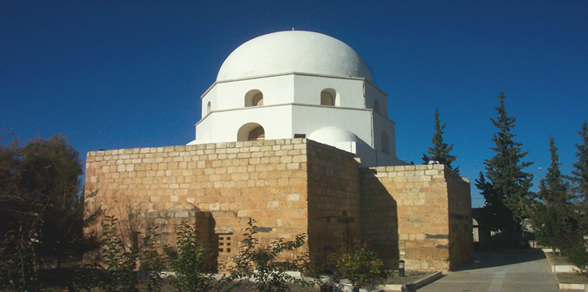
Image 1 – Umayyad Caliph Umar ibn Abd al-Aziz Shrine in Deir Sharqi village, taken before it was vandalized. Credit: Madain Project.
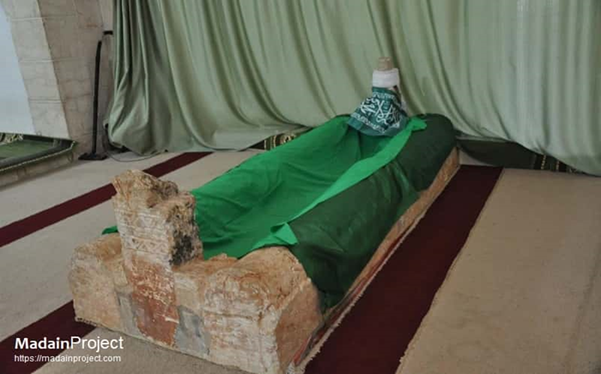
Image 2 – the Umayyad Caliph Umar ibn Abd al-Aziz Shrine in Deir Sharqi village, taken before it was vandalized. Credit: Madain Project.
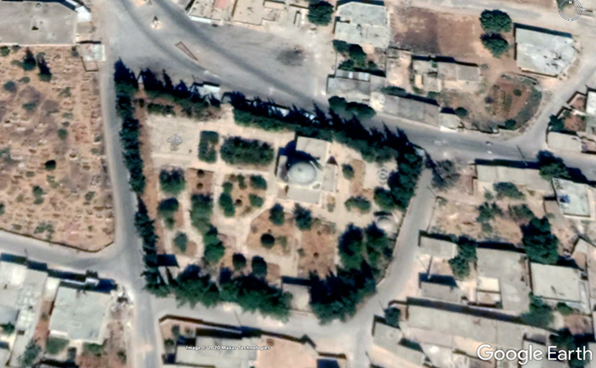
Image 3- Satellite image locating Umayyad Caliph Umar ibn Abd al-Aziz Shrine on 11 September 2019, a few months before the Syrian regular forces controlled the area.
Constructing A Timeline of Events
On 24 January 2020, Syrian regular forces announced their advance into several towns south of Idlib, including Deir Sharqi, where the Umayyad Caliph Umar ibn Abd al-Aziz Shrine is located. The town was previously held by the military group Hayat Tahrir al-Sham (HTS).
On 25 January 2020, pro-government Facebook pages, such as Hama News[1] and Aleppo News Network,[2] posted photos of the shrine, displaying the partial damage of the structure, likely caused by aerial shelling. However, the photos showed that the building surrounding the graves remained intact, with paintings still hanging on the walls and other cultural artifacts secure in the room.
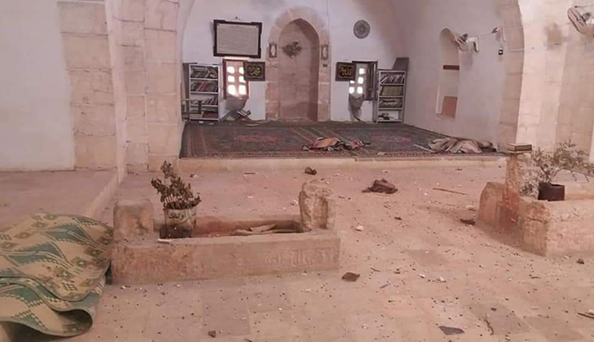
Image 4-The Caliph Umar ibn Abd al-Aziz Shrine following the Syrian regular forces’ control over Deir Sharqi town. Credit: Hama News.
While Caliph Umar’s shrine remained largely intact at this point in January, the area surrounding the shrine suffered massive infrastructural damage during the shelling of Deir Sharqi town by Syrian regular forces as they assaulted the city. Media activist Anas al-Ma’arawi documents the damage in a video published in early January 2020. [3]
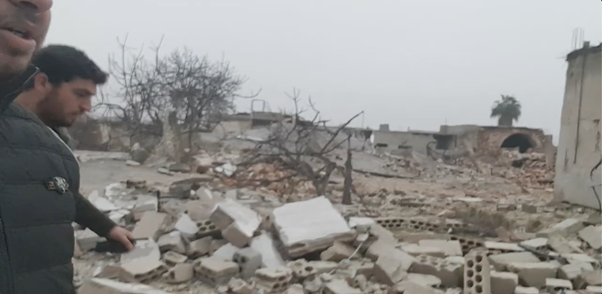
Image 5 – Screenshot from video showing massive damage in the area near the Caliph Umar shrine.
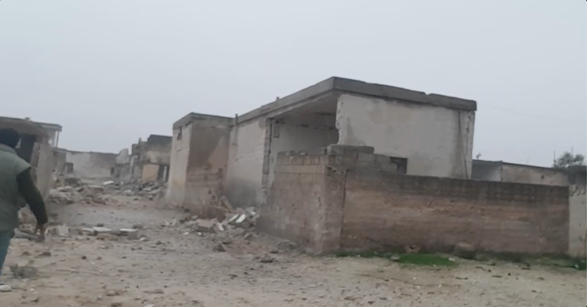
Image 6 – Screenshot from video showing massive damage in the area near the Caliph Umar shrine.

Image 7 – This photo provides analysis of the visual evidence of the decimation in the area near the Caliph Umar ibn Abd al-Aziz Shrine, as shown in the video published by media activist Anas al-Ma’rawi.
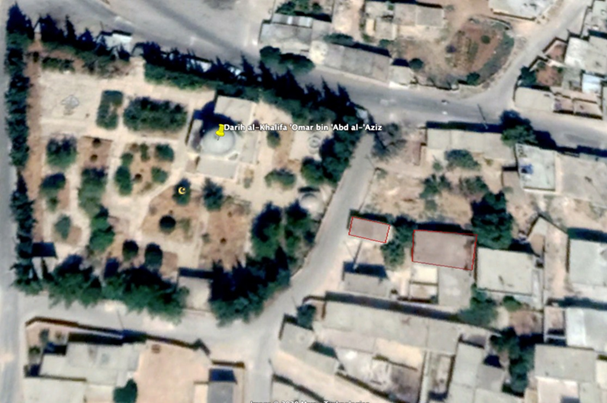
Images 8- Visual evidence of the decimation in the area near the Caliph Umar Shrine

Image 9- Satellite image locating the destroyed sites reported in the video published by media activist Anas al-Ma’rawi, as caused by the shelling on Deir Sharqi town. Red locaters indicate large-scale damage. Orange locaters indicate partial damage.
On 28 January, three days after loyalist Facebook pages published photos of the shrine in relatively good condition, and a few days after Syrian regular forces took control over the city, the State-run Syrian SANA published another set of photos[4] and reported that the shrine had been further vandalized and burned by “terrorists” in Deir Sharqi town and Talmenes village, south of Idlib.
SANA’s photos show the large-scale damage that befell the shrine in late January. A fire appears to have burned the building housing the graves of Umar ibn Abd al-Aziz, his wife, and attendant. Despite evidence of the fire, a few of the shrine’s artifacts like books and paintings remain in the same places as they appeared in the early January photos published by pro-government Facebook pages.
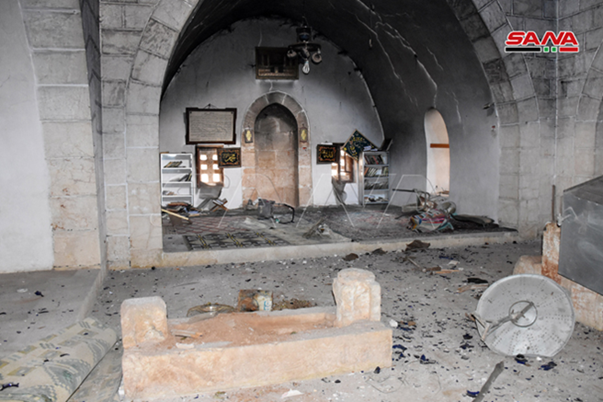
Image 10 – Photo published by SANA, captioned as acts of vandalism and fire perpetrated by so-called “terrorists” against the Caliph Umar ibn Abd al-Aziz Shrine.
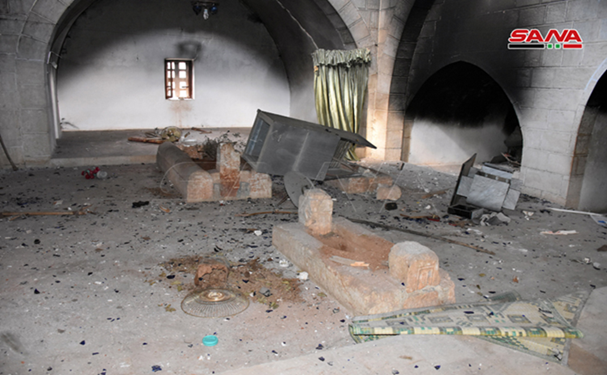
Images 11-A photo published by SANA, captioned as acts of vandalism and fire perpetrated by so-called “terrorists” against the Caliph Umar ibn Abd al-Aziz Shrine.
On 26 May 2020, while the Syrian regular forces controlled the town of Deir Sharqi, media activists circulated a video[5] reporting that the shrine had been further vandalized. The activists said that the offenders raided the shrine and sabotaged its three graves They attributed these abuses to the Syrian regular forces and their allied militias, claiming that the contents of the Caliph Umar ibn Abd al-Aziz Shrine were looted and transported to an unknown location – including the Caliph’s body.
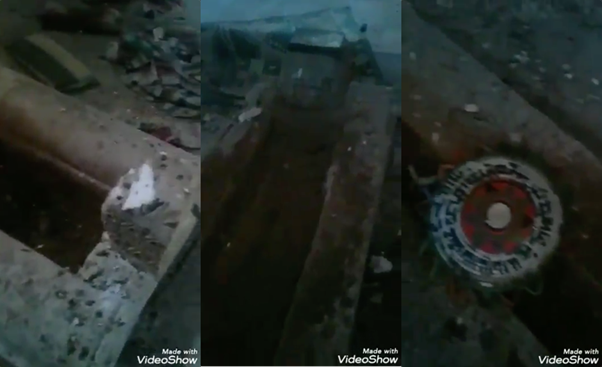
Image 12- Screenshot from Anas al-Ma’rawi’s video, showing the damage that befell the Caliph Umar ibn Abd al-Aziz Shrine in Deir Sharqi town on 26 May 2020.
The Syrian Ministry of Awqaf on 5 June 2020 published a statement regarding the Caliph Umar ibn Abd al-Aziz Shrine[6] denying rumors by “opponent media outlets” which reported that the shrine was subjected to destruction and excavation. The ministry said:
“Opponent media outlets, which support terrorists, have published videos of vandalism at the shrine of the just and rightful Caliph Umar ibn Abd al-Aziz, may God be pleased with him. After Ma`arat al-Nu`man was liberated from the wickedness of terrorist groups, the Ministry of Awqaf examined the site of the Caliph Shrine. It confirmed that neither the grave, nor the body, of Caliph Umar ibn Abd al-Aziz were tampered with, even though there are some marks of destruction on the walls and the shrine’s site done by the terrorist gangs and the al-Nusra Front.”

Image 13- The statement made by the Syrian Ministry of Awqaf regarding vandalism of the Caliph Umar ibn Abd al-Aziz Shrine. Credit: Official Facebook page of the Ministry of Awqaf.
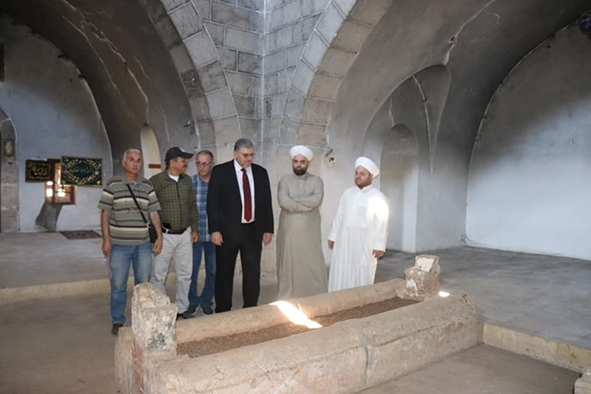
Image 14
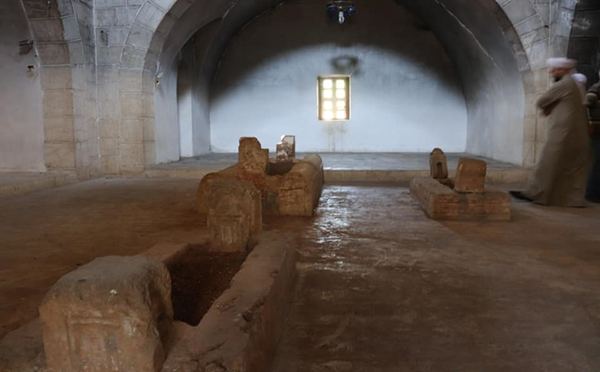
Images 14, 15- The two photos are of the Caliph Umar ibn Abd al-Aziz Shrine after it was renovated by the Syrian Ministry of Awqaf. Credit: Official Facebook page of the Ministry of Awqaf.
On 8 June 2020, the Ruptly video news agency published a set of photos of the Caliph Umar ibn Abd al-Aziz Shrine demonstrating interior and exterior renovation .[7]
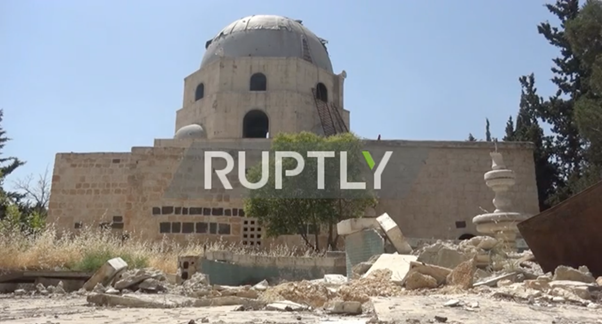
Image 16
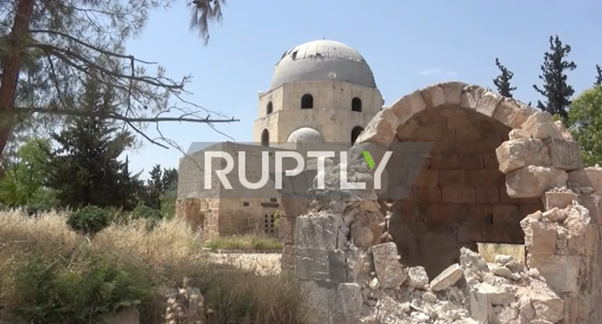
Image 17
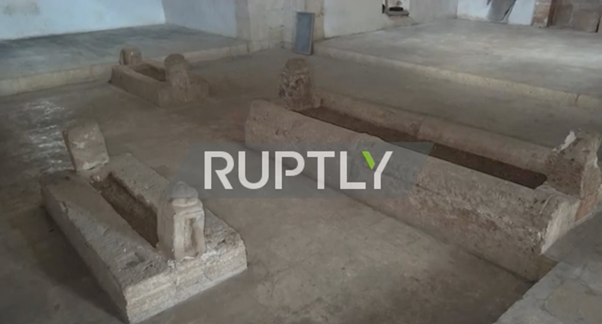
Images 16, 17, 18- The photos are of the Caliph Umar ibn Abd al-Aziz Shrine, renovated inside and outside. Credit: Ruptly video news agency.
Comparing the video posted by media activists and the photos by SANA throughout January, STJ’s digital forensic analyst concluded the shrine had likely been damaged when the Syrian regular forces took control over Deir Sharqi town on 24 January 2020.
Before January 24, the town was subjected to extensive aerial shelling. Consequently, our digital forensic analyst believes that the shelling is likely responsible for the damage apparent to the shrine prior to Syrian regular forces taking control of Deir Sharqi.
The digital forensic analyst added that the shrine was likely subjected to further damage in the period between January 24 and January 28, given apparent evidence of fire and the shrine’s black walls. This occurred over the period that separated the Hama News’s photos, on 25 January 2020, and SANA’s photos, on 28 January 2020, namely during the Syrian regular forces’ control of the area.
By May 2020, it appears that the shrine only suffered some additional vandalism. STJ’s digital analyst concluded that much of the damage in the May video is identical to those in SANA’s January photos, with the exception of a few signs of additional harm.
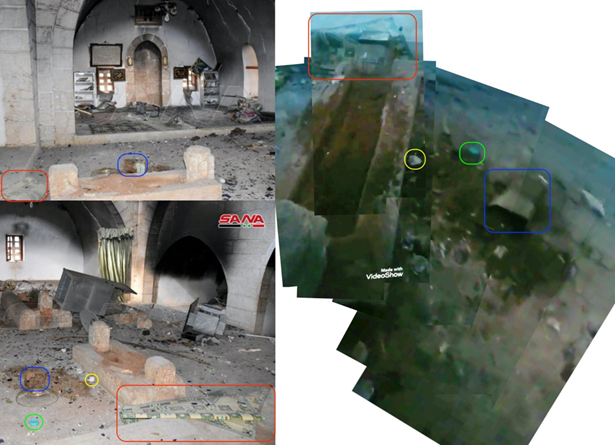
Image 19- Comparison between the video and SANA’s photos, demonstrating that the damage in the photos is extremely similar to that in the video, with only minor additional harm at the shrine, as belonging to May 2020.
- Accounts by activists and eyewitnesses
To obtain additional evidence regarding the vandalization of the Caliph Umar ibn Abd al-Aziz Shrine, STJ interviewed a number of activists and eyewitnesses, including media activist Anas al-Ma’arawi.
Activist al-Ma’arawi confirmed to STJ that he visited the shrine a few days before the Syrian regular forces took over the region. He documented the damage to the building surrounding the shrine’s structure due to the government forces’ bombardment of Deir Sharqi.[8] He added that the shrine was then intact on the inside and there were no marks of sabotage.
The second witness that STJ met is a resident of Deir Sharqi town. He lives only 50 meters away from the shrine and left the town a few hours before the Syrian regular forces managed to take control. The resident’s account matches al-Ma’arwai’s. He said that the shrine was almost untouched on the inside and the material damage occurred exclusively at the shrine’s exterior, caused by the Syrian regular forces’ shelling.
A third witness told STJ that, when they took control over Deir Sharqi, the Syrian regular forces were stationed near the shrine’s building— only 150m away. The forces established military posts for the 25th Division, in addition to reenforcing posts belonging to the 9th Division. This deployment would have made it difficult for any armed group or individuals to access the shrine and set it aflame after their arrival.
Other witnesses from Deir Sharqi town told STJ that jihadist organizations, such as the extremist Tanẓīm Ḥurrās ad-Dīn/Guardians of Religion Organization, had previously attempted to vandalize the shrine. However, the town’s people thwarted their efforts.
Given the likely timeline of events, visual evidence, and witness testimony, STJ’s experts concluded that the Caliph Umar ibn Abd al-Aziz Shrine was not vandalized by “terrorist” groups as Syrian media sources claimed, and instead was likely damaged by Syrian regular forces as they attempted to take control of Deir Sharqi town and during their time stationed there.
Read the full report as a PDF by following this link.
_____
[1] The Turkish army, supported by several armed opposition groups, embarked on military Operation Olive Branch in Afrin city on Saturday, 20 January 2018. The operation ended with the allied forces’ control over the city’s center on Sunday, 18 March 2018, after 59 days of fighting.
[2] “Syria: New Visual Evidence of Bulldozing the ‘Ali Dada’ Historic Shrine in Afrin,” STJ, 10 September 2019. https://stj-sy.org/en/syria-new-visual-evidence-of-bulldozing-the-ali-dada-historic-shrine-in-afrin/ (last visited: 25 February 2021).
____
[1] For more: https://m.facebook.com/614856112359900/photos/pcb.802516976927145/802516913593818/?type=3&source=48
[2] For more: https://m.facebook.com/story.php?story_fbid=2606342889651127&id=1407430666209028&refid=52&__tn__=-R
[3] For more: https://www.youtube.com/watch?v=jACBt83LGQE
[4] For more: http://www.sana.sy/wp-content/uploads/2020/01/16-41.jpg
[5] For more: https://twitter.com/ahmadal_shame/status/1265357310475501568?s=20
[6] For more: https://www.facebook.com/awkafsyrian/posts/3577513712275968
[7] For more: https://www.ruptly.tv/en/videos/20200608-021-Syria–Tomb-of-Caliph-Omar-bin-Abdul-Aziz-to-reopen-after-repairs
[8] For more: https://www.youtube.com/watch?v=jACBt83LGQE&feature=youtu.be


1 comment
[…] example, in 2020, Syrian regular forces and allied militias vandalized the Caliph Umar ibn Abd al-Aziz Shrine in rural Idlib. In other incidents, Syrian regular forces […]